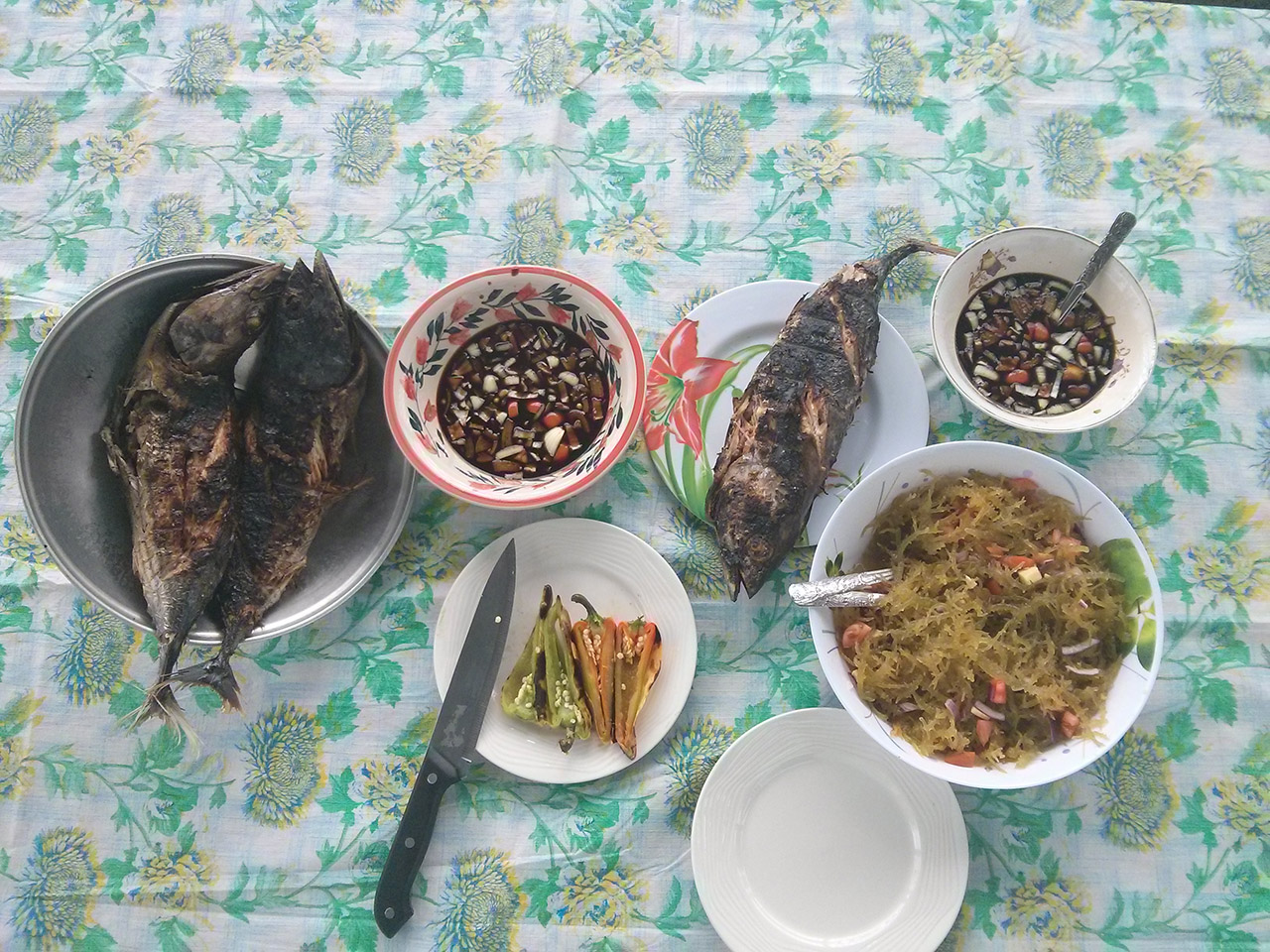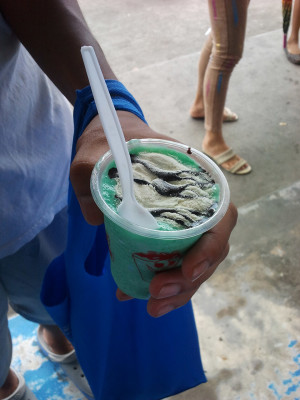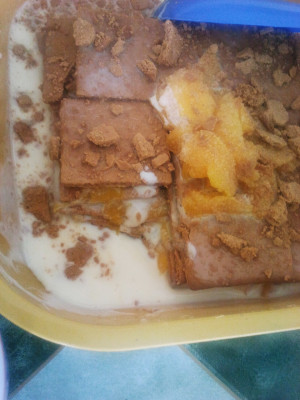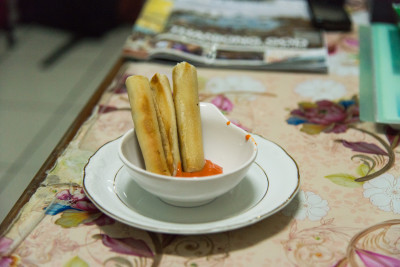Leyte foodie guide

What the city lacks in McDonalds and other Western establishments, it more than makes up for it with an abundance of local bakeries and food vendors. There’s a bakery on nearly every street and the inviting smells that emanate out of these businesses each morning is simply intoxicating. One bakery in particular stood out for me: Julie’s Bakeshop is a self service bakery which allows you to pick the best looking piece of bread or pastry before heading to the register. Even better is that you can see the bakers making the very bread you’re buying right behind the plastic containers and if you time it just right, you can get your favorite piece of pastry mere seconds after it exits the oven! My two favorites were the choco german bread, which is a sweet roll with chocolate swirls folded in the dough and the Pinoy classic, Spanish bread. I’ve had a lot of Spanish bread here in the States and let me tell you, they don’t hold a candle to what I had at Julie’s; I might never find an equal here in California. The best part is that you can get a dozen Spanish bread for $1.25! You’d be lucky to get six here in California for 4 bucks!
Leyte also has its own version of “iskrambol” (basically the word ‘scramble’ with a Pinoy accent), a crushed/shaved ice dessert that can be found all over the islands. This frosty treat is particularly popular with the youth, and not just because it’s so refreshing to have on a balmy tropical afternoon, but because it’s also very affordable, with the average price around P10.
Popsicles and ice cream are considerably pricier than a cup of iskrambol so the kids and teenagers alike naturally flock to the vendors on the street. Its low price can be attributed to its simplicity; it’s a cup of finely crushed ice, flavored with pandan (a common, plant-based Southeast Asian flavoring) and topped with a number of sweet bric-a-brac, like powdered milk, candy sprinkles, chocolate cereal flakes and other things that kids go crazy about, but selection tends to vary depending on the vendor. The flavor combinations might not sound especially appetizing, but trust me, somehow it just works. You’re not going to hesitate chewing on those chocolately cereal pieces and marshmallows while you sip on the citrusy pandan flavored slush; it sends a wave of cooling satisfaction all the way down to your toes.
During some of our downtime, I had the pleasure of helping Lormi prepare her version of a popular Filipino dessert, the mango float. The Filipino mango is a truly unique fruit as it has practically no other equal here in the States or any other place I’ve been to. Its combination of sweetness and tang is a flavor that all Filipinos are familiar with and depending on where you live, it may take great lengths to be able to get your hands on some. Even in Baybay, at times it was difficult to get mangoes of the right condition and ripeness for use in making the dessert. The mango float is a Filipino interpretation of a mango cake and as with other Filipino interpretations of Western dishes, it makes creative use of substitute ingredients to achieve a result that is nearly identical to the original, though I should warn you that there are no hard and fast rules on what can be used as substitutes so the end result will be dependent on the person preparing the dish. For Lormi’s version, the cake portion is made up of graham cracker layers and a mixture of semi-whipped canned cream and condensed milk is used in place of the cake frosting. In between the cracker layers and frosting are thin slices of just barely ripe Filipino mangoes.
After the components are assembled, the whole container is then refrigerated for a few hours. Surprisingly enough, the end product is in fact incredibly similar in both taste and texture to an actual cake! Once the graham crackers absorb some of the cream mixture, they take on a fluffy cake like consistency that is nothing like the soggy cracker that I was expecting and the slight tartness of the mango contrasted really well with the sweetness of the condensed milk and cream mixture. As far as interpretations go, this one is a winner! I might have to steal this recipe for use here in the States, with substitutions and all!
As far as local delicacies go, I was able to try a new dish prepared by an aspiring entrepreneur and offered at a recent local fair. They call it “flavey bread” and it bears a resemblance to a more recognizable Filipino delicacy, the fried lumpia. However, that’s where the similarities end; flavey bread is basically vegetables and cheese rolled up in a pancake and then tossed in the fryer. The rolled pancake doesn’t make much for a crunchy exterior even after being fried, but the crisp strips of vegetables and the intense flavor of the cheese makes for an interesting little snack. It’s also served with a variety of dipping sauces; our sample had something that reminded me of Thousand Island dressing, but it was likely ketchup mixed with mayonnaise, a favorite among Pinoys. It was too bad our sample was not fresh from the fryer; as good as it was, I can only imagine how much better it would have been just out of the oil.
Baybay is also known for its numerous bbq stands that line the downtown plaza area and sadly, I didn’t get a chance to sample every single one of them. However, if you ask the locals, most of them will tell you that one stand stands above all the rest and that stand is “Minggai’s”. Nestled in between two karaoke bbq joints is a small, dirt-floored dining area with a bbq pit at center stage. Even early in the afternoon, the fires of the grill are roaring and the smell of charred meat fills the air around you. You know you’re in the islands when you see the proprietress preparing the skewered goodies in plain view in a dimly lit portion of the stand with bugs and geckos visibly crawling about the walls and ceiling; clearly health inspectors have no power here. However, you don’t
really have to worry too much about bacteria and food poisoning, as the heat of the flames is sure to destroy any invisible bugs that may have taken up residence in the meat. And what flavorful meat it is, even though we had to wait for the rest of of lunch to be prepared at home before diving into the bbq, it was still very tender and juicy.. Couple it with the chili and calamansi infused soy sauce they include with every order and you have yourself a very a satisfying meal.
I’ve only begun to scratch the surface of the culinary scene here in Leyte, so I’ll definitely be sampling more of the bbq stands next time around! If you ever find yourself here, let go of your inhibitions and preconceptions about proper food preparation and dig in! As long as you have access to a toilet and running water, I promise it’ll be worth it to try the local fare!



